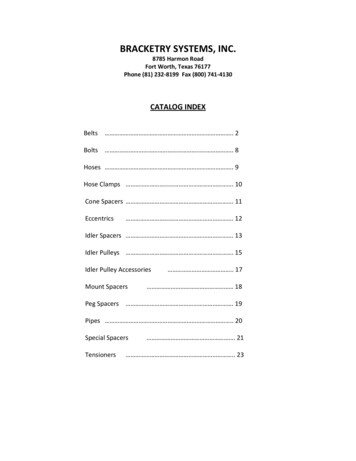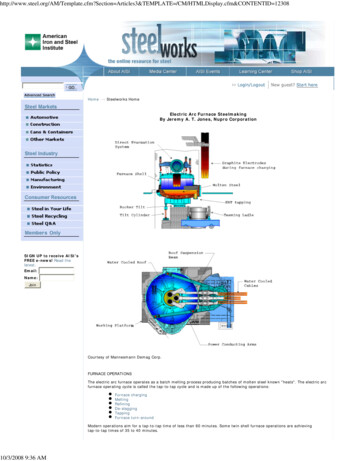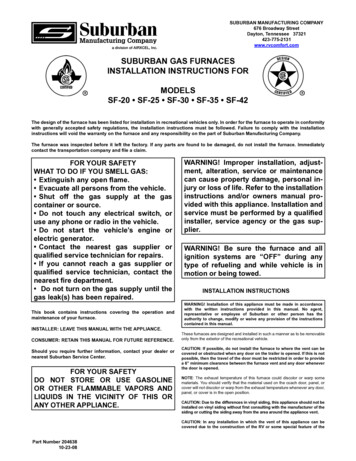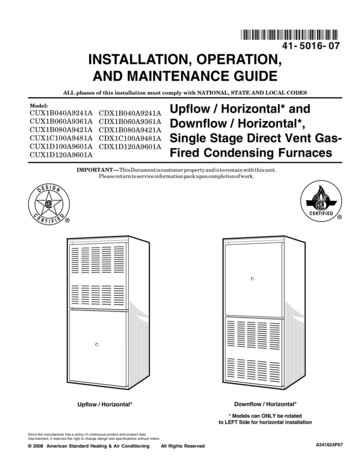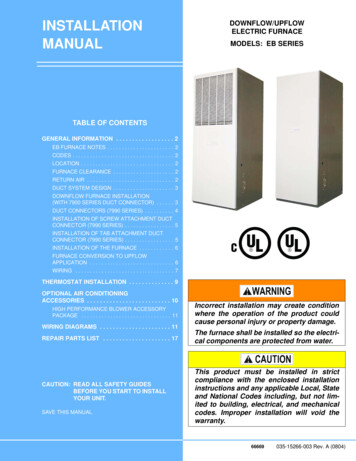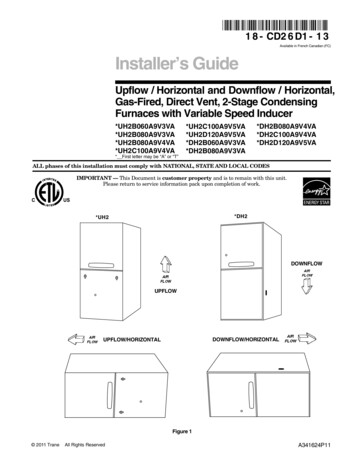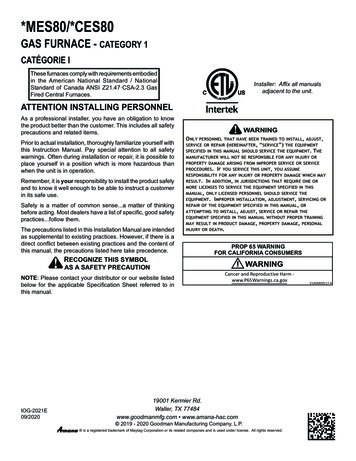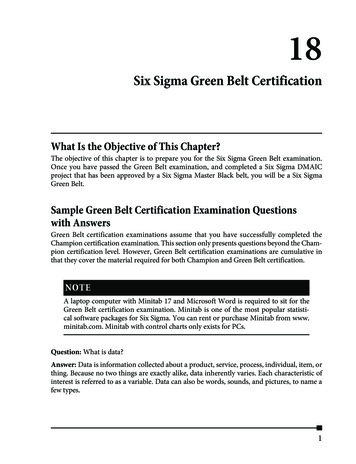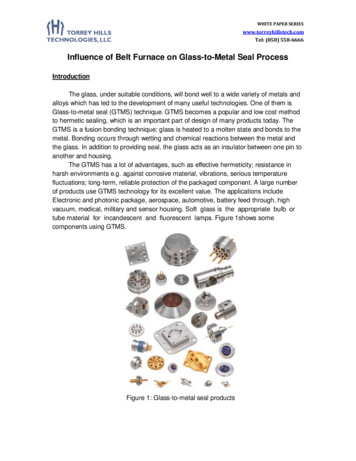
Transcription
WHITE PAPER SERIESwww.torreyhillstech.comTel: (858) 558-6666Influence of Belt Furnace on Glass-to-Metal Seal ProcessIntroductionThe glass, under suitable conditions, will bond well to a wide variety of metals andalloys which has led to the development of many useful technologies. One of them isGlass-to-metal seal (GTMS) technique. GTMS becomes a popular and low cost methodto hermetic sealing, which is an important part of design of many products today. TheGTMS is a fusion bonding technique; glass is heated to a molten state and bonds to themetal. Bonding occurs through wetting and chemical reactions between the metal andthe glass. In addition to providing seal, the glass acts as an insulator between one pin toanother and housing.The GTMS has a lot of advantages, such as effective hermeticity; resistance inharsh environments e.g. against corrosive material, vibrations, serious temperaturefluctuations; long-term, reliable protection of the packaged component. A large numberof products use GTMS technology for its excellent value. The applications includeElectronic and photonic package, aerospace, automotive, battery feed through, highvacuum, medical, military and sensor housing. Soft glass is the appropriate bulb ortube material for incandescent and fluorescent lamps. Figure 1shows somecomponents using GTMS.Figure 1: Glass-to-metal seal products
WHITE PAPER SERIESwww.torreyhillstech.comTel: (858) 558-6666There are majorly two types of seal, one is compression seal and the other ismatched seal. The compression seal is designed to exert concentric compressive stresson the glass in the available temperature range, while considering the thermal expansioncoefficients of the metal and glass. The matched seal type is majorly designed to sealFe-Ni-Co alloy (Fe: 54%, Ni: 28, Co: 18%), known as Kovar, with glass. The thermalexpansion coefficient of Kovar synchronizes with that of glass over a wide range oftemperatures. The matched seal type can be used to make a variety of terminals withcomparatively few restrictions on the terminal shape. At the same time, it provides highair-tightness and electrical insulation. So most application, from light bulbs to electronicpackaging, are using matched seal type.Process of Glass-to-Metal SealA typical glass-to-metal seal consists of the following elements: 1) A metal bulk head(or body) with a hole in it; 2) A pin conductor in the center of this hole; 3) A piece of glasspre-formed to fit between the pin and the bulk head.During GTMS processing, these three components are placed on a fixture whichholds them in position. The components are assembled with the glass in the form ofsmall items placed in or around the metal parts. The components are placed in a furnaceconfigured to maintain a controlled atmosphere in the firing chamber. During thecomponents go through the furnace, they are heated to appropriate temperatures for theparticular set of materials, which the intention is to let the glass soften just sufficiently.At the sealing temperature, the glass melts and flows gently into place to fill the spacebetween the pin and the bulkhead, making a good seal to the metal. The assembly isthen cooled. The temperature of the process should be specific controlled for goodqualified products. Figure 2 shows a schematic of GTMS process of belt furnace.It is significant for the glass not to become too runny, nor stay too stiff. A carrier maybe used to take a lot of little parts through the belt furnace at once. Generally, the wholeprocess is nearly continuous when moving through the furnace and the temperaturewould change gradually during the pass. Once the temperature can get the crucial glassbits, the glass can fill the adjacent metal well.
WHITE PAPER SERIESwww.torreyhillstech.comTel: (858) 558-6666Figure 2: Schematic of a typical GTMS of belt furnace.The Properties of Glass for GTMS ProcessThe quality glass-to-metal seal is pretty influenced by the glass. As an engineeringmaterial, glass is unique. Two of the most significant properties that make it so, one isthe mechanical strength, and the other is viscosity. Glass is a brittle material but onethat is truly elastic with no plastic deformation to failure.The intrinsic strength of glass is extremely high and certain experiments havesubstantiated. Glass, at room temperature, actually is a viscous material and it has nottrue melting points. But its viscosity will reduce when temperature increasing, and theviscosity reduction is approximately exponential with temperature. The significantviscosity reduction zone is between 500 C and room temperature. So during the GTMSprocess, the temperature heating in furnace is significant.Volume resistivity of glass at ordinary room temperature varies widely with thecomposition from as low as 108 to as high as 1019 ohm centimeters. During the GTMSprocess, the volume resistivity of glass decreases with increasing temperature, Figure 3.Consequently, we have to take this issue into account when considering operations atelevated temperature by furnace.
WHITE PAPER SERIESwww.torreyhillstech.comTel: (858) 558-6666Figure 3: Change in glass resistivity with temperatureImproved Glass-to-Metal Seal Through Furnace ControlThe ultimate goal of making the matched glass-to-metal seal is to produce aconsistently reliable end product which will retain its hermeticity throughout its useful life.The hermeticity and strength directly influence the reliability of the components of whichthey are a part and can cause or prevent potentially catastrophic component failure. Toimprove the hermeticity of GTMS process and produce a more reliable product at higherlevels of consistency majorly relies on more precise control over furnace atmospherecomposition.As former study recommended, a consistent 2.0-6.5 μm residual intergranular oxide,which is tighter control by the preoxidation, is best for the performance. And thepreoxidation is deeply influenced by the composition of H2 and N2. All of theseoperations can be performed on a continuous mesh-belt furnace and require a protectiveatmosphere of some type. As the preoxidation is significant for sealing process, aprecise control through the use of humidified H2-N2 furnace atmosphere should beapplied. This process control could offer consistently produce desired oxide depths. Aschematic of the control system for belt furnace is depicted in Figure 4.
WHITE PAPER SERIESwww.torreyhillstech.comTel: (858) 558-6666Figure 4: Schematic of H2-N2 atmosphere system of belt furnaceBy blending H2, N2, and H, O people can exercise the process control necessary forthe production of consistently reliable seals. Precise blending of the furnace atmospheredoes allow repeatable formation of intergranular oxide within acceptable limits. This isthe basis for producing matched glass-to-metal seals which have the durability to meetthe necessary specifications continually.Furnace for Glass-to-Metal SealThe HSA series belt furnace is well designed for glass-to-metal seal process, Figure5. This furnace uses ceramic heater boards to achieve elevated temperatures. The HSAseries furnace comes with a refractory heating chamber equipped with ceramic fiberheating board. The heating works to give fast thermal response. The furnace isequipped with temperature profiling system and computer monitoring system. Moreover,it can achieve good atmosphere control including hydrogen, nitrogen, and oxygen bydew point monitoring and oxygen monitoring system. Consequently, HSA series furnacecan serve an excellent GTMS process.Forced air or water cooling is used in the cooling section of the furnace. The muffledesign located within the furnace helps with control of atmospheric conditions and alsohelps in maintaining a cleaner environment inside the furnace. As a standard feature,this furnace is equipped with a steel brush for cleaning the conveyor belt; however,ultrasonic belt cleaning is available as an extra option. It is a really clean environmentapplication furnace.
WHITE PAPER SERIESwww.torreyhillstech.comTel: (858) 558-6666Figure 5: Hengli HSA series belt furnaceThe HSA series furnace has a microprocessor based PID controller to control thefurnace. Type K thermo-couples are used in determining the zone temperatures and thecontrols are located on the right hand side of the furnace which can be viewed from theentrance. The central processing unit (CPU) is located at the exit table and is primedwith a Windows operating system for ease of use. The computer system is pre-installedwith a program for controlling the furnace parameters, including the belt speed, zonetemperatures, and atmospheric conditions. Temperature profiles can be stored andretrieved as well for future purposes. The furnace already has programs in the softwarefor capturing/storing, displaying, and printing out the furnace profile. Thermocouple portsare located at the entrance table for connecting the profiling thermocouple directly intothe microprocessor. This feature allows for the monitoring and recording of actualtemperatures experienced by the part. Additionally, the furnace is equipped with aredundant overheat safety protection system which incorporates an additional type “K”thermocouple in the center of each controlled zone and the multi-loop alarm. Thespecification of a HSA7503-082N belt furnace is listed in Table 1.
WHITE PAPER SERIESwww.torreyhillstech.comTel: (858) 558-6666Table 1: Specification of HSA7503-082N belt furnaceConclusionTo improve GTMS process should consider a great number of conditions. The propertemperature control and precise time control are fundamental of a good GTMS furnace.Moreover, the atmosphere composition of GTMS process is always vital for the effectiveGTMS process and excellent quality of product. By blending the H2, N2, and H, O, wecan get an ideal environment for GTMS process. The efficiency and quality will increasewhen the belt furnace can handle these requirements well.
Glass-to-metal seal (GTMS) technique. GTMS becomes a popular and low cost method to hermetic sealing, which is an important part of design of many products today. The GTMS is a fusion bonding technique; glass is heated to a molten state and bonds to the metal. Bonding occurs through wetting and chemical reactions between the metal and the glass.
